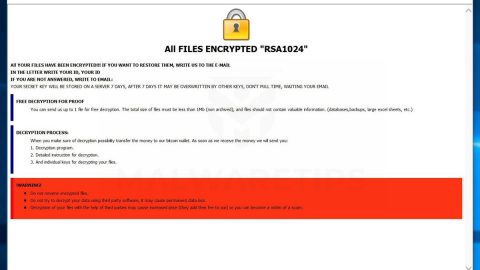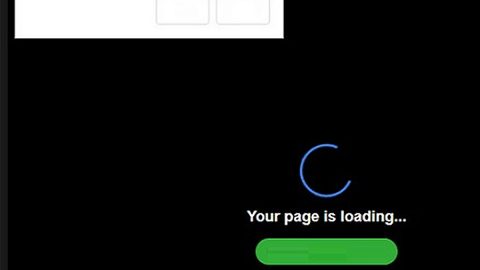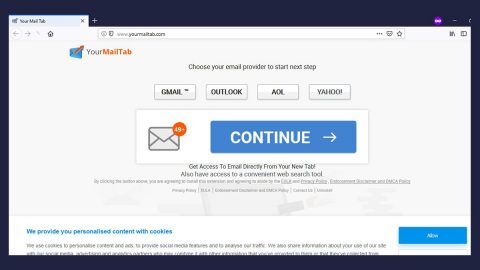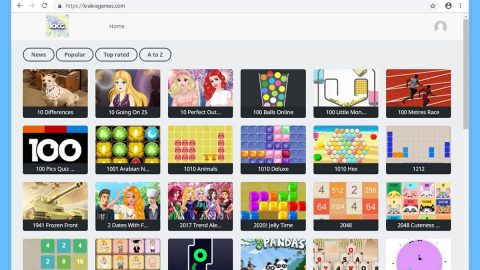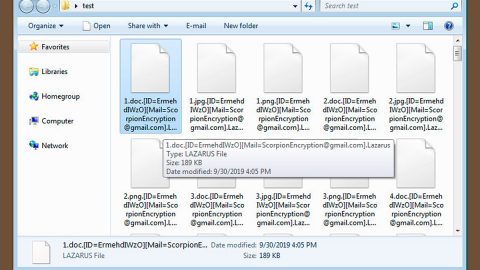What is Proticc ransomware? And how does it carry out its attack?
Proticc ransomware is a new crypto-virus that claims to encrypt files although according to security experts, it doesn’t really encrypt files but only adds the “.lol
extension to make them look like they were encrypted. After its supposed encryption, it locks the screen of the infected computer making it hard for victims to access their PCs.
Once it infiltrates a computer, Proticc ransomware might drop its malicious payload and establish a connection to a remote Command and Control server managed by the attackers. From this remote server, it downloads other malicious components that are used to carry out its attack. They may be placed on system folders. It then uses an information gathering module used to gather data about the user and the infected computer. After that, the harvested data is then used for the stealth protection module used to keep the crypto-malware from being detected by any security programs installed in the system.
In addition, it also makes modifications in the Windows Registry by creating additional entries and altering some sub-keys which allows it to run on every system startup. This makes the threat persistent and will be more difficult to terminate from the compromised PC. After all these changes, it starts to scan the entire drive of the computer in search for files with the following extensions:
.txt, .doc, .docx, .xls, .xlsx, .pdf, .pps, .ppt, .pptx, .odt, .gif, .jpg, .png, .db, .csv, .sql, .mdb.sln.php, .asp, .aspx, .html, .xml, .psd, .frm, .myd, .myi, .dbf, .mp3, .mp4, .avi, .mov, .mpg, .rm, .wmv, .m4a, .mpa, .wav, .sav, .gam, .log, .ged, .msg, .myo, .tax, .ynab, .ifx, .ofx, .qfx, .qif, .qdf, .tax2013, .tax2014, .tax2015, .box, .ncf, .nsf, .ntf, .lwp
Once it finds the files with the aforementioned extensions, it supposedly encrypts files and adds the .lol extension to each one of them. After that, it locks the screen with a ransom message that contains the following content:
“Proticc Ransomware
YOU HAVE BEEN ENCRYPTED BY PROTICC
RANSOMWARE !
Your personal files have been safely encrypted on this PC: photos, videos,
documents, etc. Below you can see a list with encrypted files. To decrypt
them you need to enter a valid key. Hurry up because you have ONLY 1
HOUR to decrypt them, when the timer finishes all encrypted files will be
deleted!
Good Luck!
List with encrypted files:”
How does Proticc ransomware spread online?
It isn’t clear how Proticc ransomware spreads online but it might spread via spam emails. Usually, cyber crooks attached an infected file on spam emails. The infected file may be a document with malicious macro scripts used to install Proticc ransomware in the targeted machine. This is why you need to be more cautious in downloading attachments from emails no matter who the sender is as crooks tend to disguise these malware-laden emails to trick users into opening them and downloading the infected attachment.
To effectively obliterate Proticc ransomware from your PC, make sure to follow the removal instructions below.
Step 1: Type in the code Hyd12UGhhzZmvF7 in the field and then click the Unlock button to regain access to your computer.
Step 2: After you’ve gained access to your computer, you need to pull up the Task Manager by tapping Ctrl + Shift + Esc keys on your keyboard.

Step 3: Go to the Processes tab and look for the process named keymaker.exe and then end its process.

Step 4: Exit the Task Manager and open Control Panel by pressing the Windows key + R, then type in appwiz.cpl and then click OK or press Enter.

Step 5: Look Proticc Ransomware and then uninstall it.

Step 6: Close Control Panel and tap Win + E keys to open File Explorer.
Step 7: Navigate to the following locations and look for Proticc ransomware’s installer and malicious components like keymaker.exe and other related files and delete them all.
- %TEMP%
- %APPDATA%
- %USERPROFILE%\Downloads
- %USERPROFILE%\Desktop
Step 8: Close the File Explorer.
Before you proceed to the next steps below, make sure that you are tech savvy enough to the point where you know exactly how to use and navigate your computer’s Registry. Keep in mind that any changes you make will highly impact your computer. To save you the trouble and time, you can just us [product-name], this system tool is proven to be safe and excellent enough that hackers won’t be able to hack into it. But if you can manage Windows Registry well, then, by all means, go on to the next steps.
Step 9: Tap Win + R to open Run and then type in regedit in the field and tap enter to pull up Windows Registry.

Step 10: Navigate to the listed paths below and look for the registry keys and sub-keys created by Proticc ransomware.
- HKEY_LOCAL_MACHINE\Software\Microsoft\Windows\CurrentVersion\Run
- HKEY_CURRENT_USER\Software\Microsoft\Windows\CurrentVersion\Run
- HKEY_LOCAL_MACHINE\Software\Microsoft\Windows\CurrentVersion\RunOnce
- HKEY_CURRENT_USER\Software\Microsoft\Windows\CurrentVersion\RunOnce
- HKEY_LOCAL_MACHINE\SOFTWARE\Microsoft\Windows\CurrentVersion\Authentication\LogonUI\Background
- HKEY_LOCAL_MACHINE\SOFTWARE\Policies\Microsoft\Windows\Personalization
- HKEY_CURRENT_USER\Control Panel\Desktop\ScreenSaveTimeOut
- HKEY_CURRENT_USER\Control Panel\Desktop
Step 11: Delete the registry keys and sub-keys created by Proticc ransomware.
Step 12: Close the Registry Editor.
Step 13: Empty your Recycle Bin.
Try to recover your encrypted .lol files using the Shadow Volume copies
Restoring your encrypted files using Windows’ Previous Versions feature will only be effective if Proticc ransomware hasn’t deleted the shadow copies of your files. But still, this is one of the best and free methods there is, so it’s definitely worth a shot.
To restore the encrypted file, right-click on it and select Properties, a new window will pop-up, then proceed to Previous Versions. It will load the file’s previous version before it was modified. After it loads, select any of the previous versions displayed on the list like the one in the illustration below. And then click the Restore button.

Once you have finished executing the given steps above, now’s the time to ensure the complete removal of Proticc ransomware using [product-name]. Simply follow the instructions laid out below.
Perform a full system scan using [product-code]. To do so, follow these steps:
- Turn on your computer. If it’s already on, you have to reboot
- After that, the BIOS screen will be displayed, but if Windows pops up instead, reboot your computer and try again. Once you’re on the BIOS screen, repeat pressing F8, by doing so the Advanced Option shows up.
- To navigate the Advanced Option use the arrow keys and select Safe Mode with Networking then hit
- Windows will now load the SafeMode with Networking.
- Press and hold both R key and Windows key.
- If done correctly, the Windows Run Box will show up.
- Type in the URL address, [product-url] in the Run dialog box and then tap Enter or click OK.
- After that, it will download the program. Wait for the download to finish and then open the launcher to install the program.
- Once the installation process is completed, run [product-code] to perform a full system scan.
- After the scan is completed click the “Fix, Clean & Optimize Now”button.






